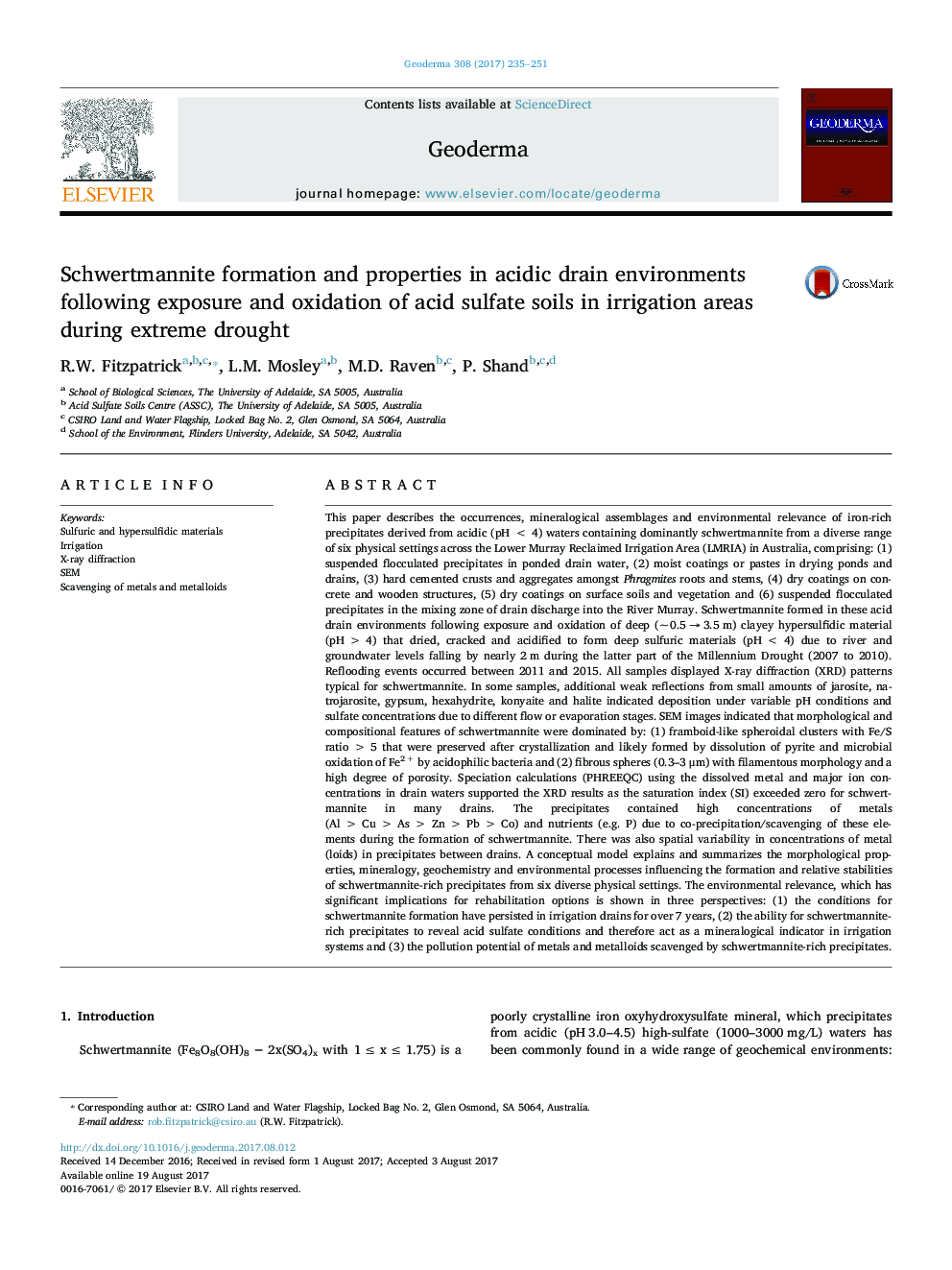| کد مقاله | کد نشریه | سال انتشار | مقاله انگلیسی | نسخه تمام متن |
|---|---|---|---|---|
| 5770567 | 1629409 | 2017 | 17 صفحه PDF | دانلود رایگان |
- Schwertmannite conditions of formation have persisted for over 7Â years in irrigation drains.
- Conceptual models explain the formation of 6 diverse schwertmannite-rich precipitates.
- Models describe relative stabilities of schwertmannite-rich precipitates.
- Speciation calculations (PHREEQC) of drain waters support the XRD and EDX results.
- High concentrations of metals [Al > Cu > As > Zn > Pb] due to co-precipitation/scavenging during formation of schwertmannite
This paper describes the occurrences, mineralogical assemblages and environmental relevance of iron-rich precipitates derived from acidic (pH < 4) waters containing dominantly schwertmannite from a diverse range of six physical settings across the Lower Murray Reclaimed Irrigation Area (LMRIA) in Australia, comprising: (1) suspended flocculated precipitates in ponded drain water, (2) moist coatings or pastes in drying ponds and drains, (3) hard cemented crusts and aggregates amongst Phragmites roots and stems, (4) dry coatings on concrete and wooden structures, (5) dry coatings on surface soils and vegetation and (6) suspended flocculated precipitates in the mixing zone of drain discharge into the River Murray. Schwertmannite formed in these acid drain environments following exposure and oxidation of deep (~ 0.5 â 3.5 m) clayey hypersulfidic material (pH > 4) that dried, cracked and acidified to form deep sulfuric materials (pH < 4) due to river and groundwater levels falling by nearly 2 m during the latter part of the Millennium Drought (2007 to 2010). Reflooding events occurred between 2011 and 2015. All samples displayed X-ray diffraction (XRD) patterns typical for schwertmannite. In some samples, additional weak reflections from small amounts of jarosite, natrojarosite, gypsum, hexahydrite, konyaite and halite indicated deposition under variable pH conditions and sulfate concentrations due to different flow or evaporation stages. SEM images indicated that morphological and compositional features of schwertmannite were dominated by: (1) framboid-like spheroidal clusters with Fe/S ratio > 5 that were preserved after crystallization and likely formed by dissolution of pyrite and microbial oxidation of Fe2 + by acidophilic bacteria and (2) fibrous spheres (0.3-3 μm) with filamentous morphology and a high degree of porosity. Speciation calculations (PHREEQC) using the dissolved metal and major ion concentrations in drain waters supported the XRD results as the saturation index (SI) exceeded zero for schwertmannite in many drains. The precipitates contained high concentrations of metals (Al > Cu > As > Zn > Pb > Co) and nutrients (e.g. P) due to co-precipitation/scavenging of these elements during the formation of schwertmannite. There was also spatial variability in concentrations of metal(loids) in precipitates between drains. A conceptual model explains and summarizes the morphological properties, mineralogy, geochemistry and environmental processes influencing the formation and relative stabilities of schwertmannite-rich precipitates from six diverse physical settings. The environmental relevance, which has significant implications for rehabilitation options is shown in three perspectives: (1) the conditions for schwertmannite formation have persisted in irrigation drains for over 7 years, (2) the ability for schwertmannite-rich precipitates to reveal acid sulfate conditions and therefore act as a mineralogical indicator in irrigation systems and (3) the pollution potential of metals and metalloids scavenged by schwertmannite-rich precipitates.
Journal: Geoderma - Volume 308, 15 December 2017, Pages 235-251
